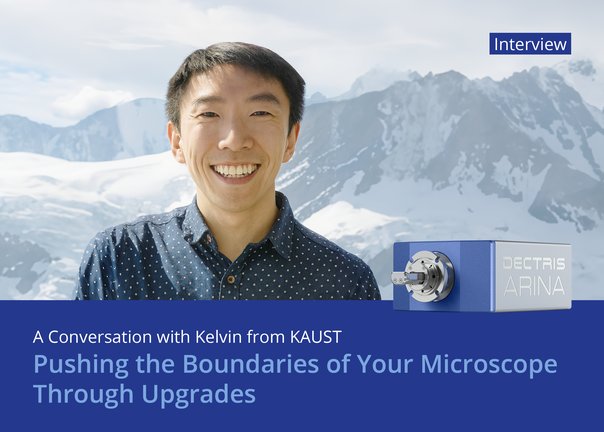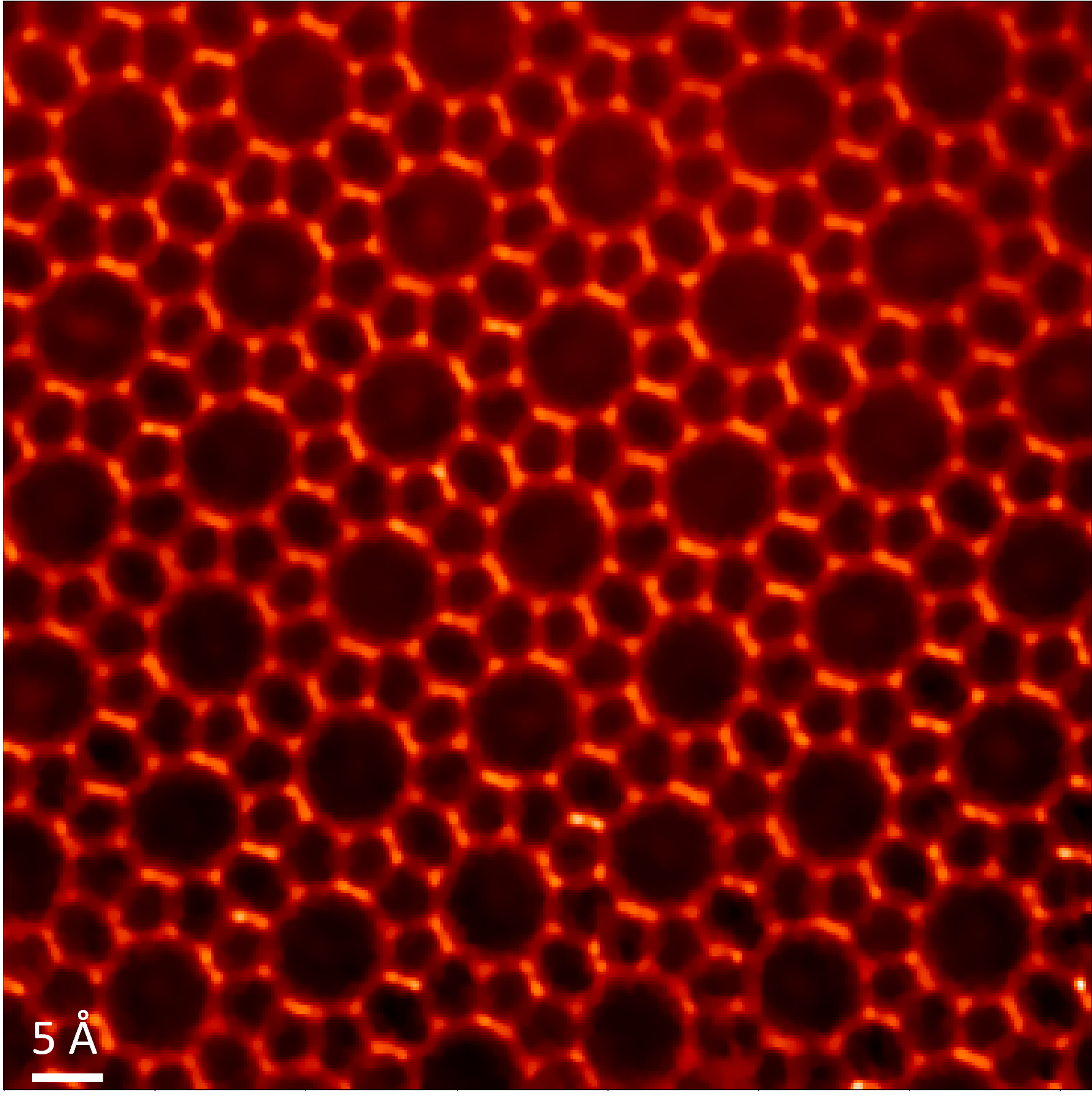
Pushing the Boundaries of Your Microscope Through Upgrades: A Conversation with Kelvin

A 10-minute read
DECTRIS: Could you please tell us about yourself and the research you are doing?
Kelvin: My name is Yiqiang Chen. But in the microscopy community, I'm known as Kelvin. I'm a Senior staff scientist from Imaging And Characterization (IAC) core lab in KAUST (King Abdullah University of Science and Technology). I have been working with transmission electron microscopy (TEM) and its instrumentation for more than 13 years in both academia and industry. I finished my PhD in quantifying the chemistry of nanoscale precipitates within TEM and since then, I have enjoyed exploring electron scattering and its imaging method, especially electron optics, which is very critical in tackling challenging applications. Now, we are excited to work with a new camera (ARINA) that helps us to push the boundaries of these applications.
DECTRIS: What do you enjoy most about working with electron microscopes?
Kelvin: When encountering an extreme application, it is often theoretically feasible from an electron scattering perspective but practically requires an instrument capable of handling it. The bottleneck typically lies in pushing the instrument to its limits, something not possible under normal circumstances. This often requires considering the full picture of electron optics rather than just a partial view, and may even involve calculating the electron-optical properties to estimate the likelihood of success. Such attempts are not always successful, but they often pay off in the long run when the insights prove valuable for other applications.
DECTRIS: Your Titan Themis Z system has been in use for many years. How have you kept it relevant to your research needs?
Kelvin: An instrument may become aged, but if it is well maintained, it can still deliver exactly what scientists need. The key question is always: how well can you maintain and upgrade it?
Maintenance itself has several layers: hardware, firmware, and software. Each one requires specific attention. If all three are cared for, even an old generation microscope can continue to achieve impressive performance. For example, with proper optimization, even first generation aberration corrected microscopes at 300 kV could still reach resolutions of around 0.7 Å.
Another crucial aspect is keeping up with technology. Instruments should be made as upgrade-friendly as possible, and we regularly integrate new components as they become available. This way, even if the base system gets out of date , it goes well along with the scientific frontier. For example, we had our Titan Themis Z upgraded with EMPAD, K3, STELA, and ARINA on the single microscope for frontier research. Each step allows the microscope to stay relevant for cutting-edge research.
So in the end, a microscope is never just "old" or "new.” It is only as current as the care, understanding, and technology we put into it.
DECTRIS: What kind of experiments or questions are you currently exploring with your microscope?
Kelvin: In KAUST, we work across the full spectrum of electron microscopy applications, different classes of materials such as nanomaterials and magnetic materials, and a variety of techniques, including TEM, STEM, differential phase contrast, 4D STEM, electron tomography, and more.
Among these, one of our central research themes is dose efficiency when imaging beam-sensitive materials. These include, for example, zeolite, MOF (metal-organic frameworks), and COF (covalent organic frameworks), which are the most important classes of catalytic materials studied nationwide in Saudi Arabia and internationally.
For us, every single electron counts. If one electron passes through the specimen but is not detected or not used for any reason, it represents a lost opportunity. That is why the recent installation of our new camera (ARINA) system has been transformative. It enables us to capture data that was simply inaccessible before. With it, we are now approaching the fundamental resolution limits set by statistical theory.
Practically, this means we are getting closer to the resolution set by statistical limit pushing several tens of e-/Ų for atomic resolution imaging. This allows us to reveal the true nature of material structures, while preserving the integrity of sensitive specimens. At this moment, that is our key application and an area where we continue to see rapid progress.
DECTRIS: You recently installed the DECTRIS ARINA detector. How has it influenced your work so far?
Kelvin: Already during the first day of training, we obtained results that completely opened our minds that a resolution of <0.9 Å resolution was obtained on one class of sensitive catalytic zeolite material. We were able to loosen the constraints on beam-sensitive materials such as COF, something we had never been able to achieve before. While I had anticipated an improvement, the scale of the leap was still surprising.
This breakthrough comes down to two key features of the camera. First, its high speed and excellent detective quantum efficiency (DQE), which ensures that nearly every electron is counted. Second, its large field of view in scanning mode, extending up to several hundred nanometers with 2k × 2k or even 4k × 4k scanning. Together, these features transform how we approach low-dose 4D STEM experiments.
Previously, limitations in speed and scanning area forced us to work under intense pressure, with very little room for error. Now, with a larger and more forgiving field of view, we can tolerate a few nanometers of "burn" without compromising the experiment. This reduces the psychological stress on operators and lowers the chance of human error, which directly translates into higher success rates.
After training both expert and non-expert users, we have already seen remarkable progress. After my training, the non-expert user can also reach roughly a 50% success rate on zeolite. This leads toward the much more challenging application of COF, where several tens to up to 100 e-/Ų is the total electron dose that can be used, including electrons spent on crystal identification. Experienced users can challenge themselves on COF for a rate of 20%. At the expert level, they can truly excel in the experiment.
Of course, the quality of sample preparation remains a critical factor. And with techniques such as tomography, success never comes in a single attempt. You need multiple trials to find the optimal parameters. But the important point is this: with the new camera, we can now routinely obtain high-quality datasets that can be reconstructed successfully. That level of productivity was not achievable before.
DECTRIS: What advice would you give to researchers managing older high-end instruments?
Kelvin: You know, it's hard to really give advice to anyone, because everyone does things a bit differently. For myself, I would say there are two things that are quite important. Firstly, gain a deeper understanding of electron optics not only to keep the instrument in good shape but also to better grasp the potential of relevant applications. Secondly, stay close to the latest technology and be ready to identify opportunities to integrate new developments into the microscope to drive new scientific applications.

A micrograph from a reconstruction of a zeolite sample at a pixel size of 0.213 Å, without upsampling fitting. The image was reconstructed from a cropped 4D STEM dataset acquired at approximately 35 nm overfocus.
To learn more about the ARINA detector, please visit the DECTRIS ARINA webpage.




